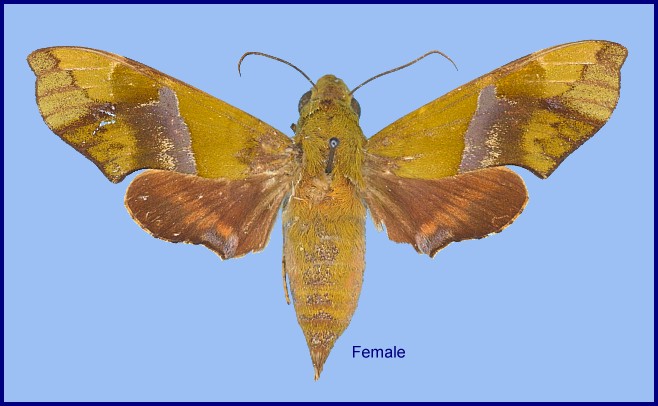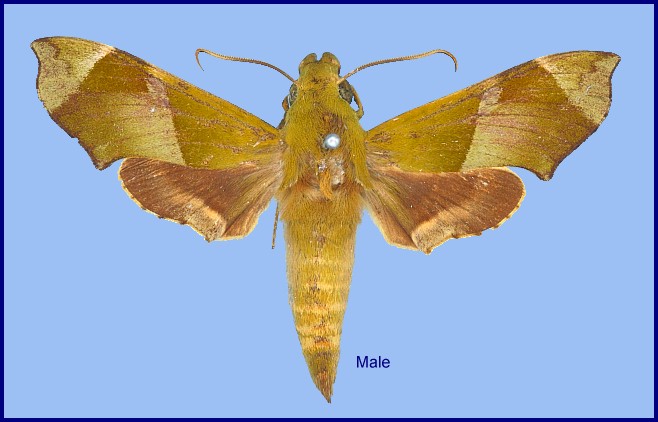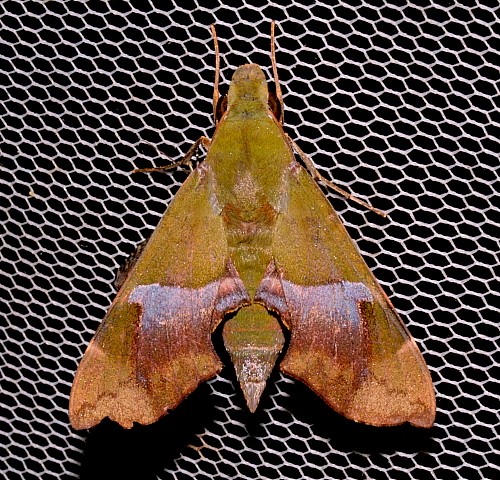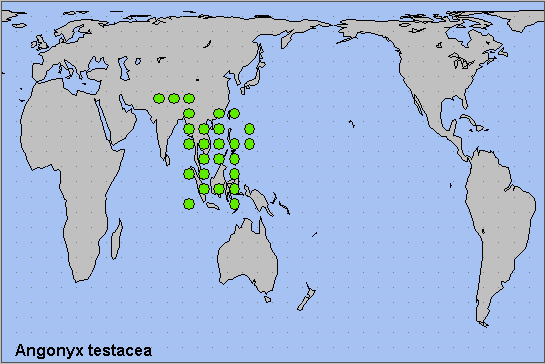

Perigonia testacea Walker, 1856, List Specimens lepid. Insects Colln Br. Mus. 8: 102. Type locality: not stated.
Synonym. Perigonia testacea Walker, 1856.
Synonym. Angonyx emilia Boisduval, 1875.
Synonym. Tylognathus emus Boisduval, 1875.
Synonym. Panacra ella Butler, 1875.
Synonym. Angonyx menghaiensis Meng, 1991.
Wingspan: 54--64mm. Forewing upperside variable in green ground colour intensity; pale band running from posterior edge of translucent discal spot to inner margin of wing variable in colour, from buff to slate grey. Hindwing upperside brown with a paler orange median band.
In the male genitalia, harpe curved broad and parallel-sided basally, abruptly tapering beyond middle to a rounded apex, with teeth along ventral edge. Phallus with left and right lobes of apical process spreading approximately at right angles, left lobe basally narrow and elbowed, ending in a patch of spines; right lobe short and broad, also with a patch of teeth apically.

The moth has been seen feeding at dusk but does not appear to be attracted by light (Bell & Scott, 1937). However, it is attracted to the flowers of Duranta erecta.
China: i-xii (Hong Kong; Guangdong); 5.iv (Lushui); vi (Hainan). Taiwan: 30.iii (Pingtung Hsien); 11.iv (Taoyuan Hsien); 17.v (Pingtung Hsien); 21.vi (Kaohsiung Hsien); 23.ix (Pingtung Hsien).
Kendrick (2002) states that this common moth is multivoltine in Hong Kong, occurring from mid February until early July, and again from late August to early January, with peaks in April, June, mid October and late November.
OVUM:
LARVA: Full-fed 65mm long, 8mm wide; horn 9 mm. According to Bell & Scott (1937), in the final instar resembling a Marumba larva in shape. Head large, semi-elliptical, dorsal line of vertex slightly depressed. True clypeus less than half length of head, apex acute, basal angles rounded; no false clypeus; labrum three-quarters length of clypeus, tapering sharply frontad. Ligula as long as labrum, long kidney shaped, sinus very deep; eyes 1 to 6 in a semicircle, 1, 2 and 3 equidistant 4 and 5 slightly more widely spaced, 6 below 6, nearly twice as far from 4 as 4 is from 3. Surface of head shiny and covered with minute hairs. Body smooth and dull. Segment 2 not as high as head, and the segments increasing gently in diameter to 5, then decreasing gently to 12. A very fine dorso-lateral, supra-spiracular and sub-spiracular hair, each rising from a minute tubercle. Horn long, straight, tapering evenly to a blunt point; rising from a fleshy cone.
Head grass-green with a narrow black cheek-stripe from vertex to base of antenna. This crosses the eyes, which are whitish with black pupils, and separates face from cheek; on the inner side of this stripe a slightly broader white stripe. Ligula fuscous-rusty colour black round the sinus; basal segment of antenna yellow, other segments white; mandible pale rusty at base, rest black. Body bright grass-green dotted with darker green, and tinged with yellowish below the dorso-lateral line, but somewhat glaucous above it. There is a dark green dorsal stripe from the front margin of segment 3 to base of horn, which is darker at the segment margins. There is also a narrow, pale vinous-brown dorso-lateral stripe slatting at front margin of 3 and running to base of horn, edged narrowly with yellow below, most strongly on segments 10 to 12. Horn plumbeous-fuscous, base paler and tip yellowish-green. True legs dark plumbeous, base and inner faces of basal segments deep orange; prolegs and claspers fuscous. Spiracles narrowly oval, flush, white with a broad, brown, transverse band across middle (Bell & Scott, 1937).
PUPA: 36mm long, 10mm wide. Dark reddish-brown, hind bevels of segments 8 to 10 dull black, spiracles and spiracular lobe of 3 dull black, cremaster shiny black. Front of head with a prominent rounded boss on each side of a wide, deeply impressed dorsal line. There is a similar boss inside of each eye. The dorsal line of segment 2 rises at an angle of about 45° to the longitudinal axis of the pupa; dorsal line of segments 3 and 4 at a less steep angle. Segments 6 and 7 tumid dorso-laterally, 7 to 9 flattened dorsally; hind margin of 11 dilated and undercut, the base of 12 fitting into it as in Acosmeryx pupae. Fore leg equal in length to antenna and about half length of wing-case; there is a narrow coxal piece. Surface of head smooth except for the tops of the bosses, which are rugose. Thorax shiny and smooth except for very superficial corrugations. Sculpturing on segment 4 in the form of a smooth, slightly raised, transverse weal, placed centrally and reaching from the subdorsal to the dorso-lateral region. Abdomen shiny and coarsely pitted, the pits better defined on segments 9 to 14. Spiracle of 2 indicated by a pear-shaped slit lying between a curved emargination of the hind margin of 2 and an oblong lobe projecting from the front margin of 3; remaining spiracles broadly oval, the central slit with raised edges. Cremaster a stout cone with a bifid tip formed of two conical teeth (Bell & Scott, 1937).
Though the colour of the pupa is similar to that of the species which pupate underground, the pupa of this species is formed in a rough cocoon on the surface. It produces a dull knocking sound when alarmed.
Larval hostplants. Strychnos nux-vomica (Loganiaceae) in India (Bell & Scott, 1937).
China: Yunnan (Xishuangbanna; Lushui, 2520m; Gaoligong Shan; Nujiang Lisu); Guizhou (Jiucai Ling); Hunan (Dayong); Fujian (Jianyang); Guangdong (Qingyuan; Shenzhen); Hong Kong; Guangxi (Chongzuo); Hainan (Changjiang Li Autonomous County; Wuzhishan; Ledong Li Autonomous County).
Taiwan: Pingtung Hsien (10km SE Mutan, 470m; Shuangliu; Kenting National Park; Neipu, 88m); Kaohsiung Hsien (Shanping, 750m; Tengzhi); Taoyuan Hsien (Guanghua, 900m); Hualien Hsien (Jinma Tunnel, 2450m).
Nepal, northern India (Subhasish Arandhara, 2016), the Andaman Islands (Kailash Chandra & Rajan, 2004), Burma/Myanmar, southern China, Taiwan, Thailand; Laos, Vietnam (Le & Vu, 2024), Malaysia (Peninsular, Sarawak), Indonesia (Sumatra, Java, Kalimantan), Philippines (Palawan, Luzon) (Inoue, 1996).
The isolated population in southern India and Sri Lanka is a separate species, namely Angonyx krishna Eitschberger & Haxaire, 2006.

 Return to Sphingidae of the Eastern Palaearctic species list
Return to Sphingidae of the Eastern Palaearctic species list